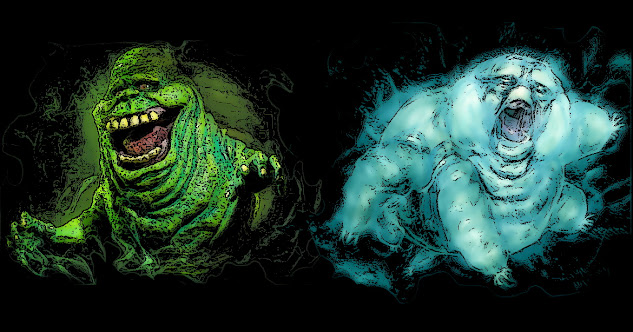What follows is a explanation (to some degree) of Ghosts in the Ghostbusters universe as it applies to my RPG campaigns. This is my personal head canon and not entirely in line with the official canon which has been somewhat inconsistent. This is my way of rectifying the discrepancies.
The information is therefore a mix of film canon, notes from deleted scenes, early drafts, unused concepts, the original West End Games Ghostbusters RPG, the Real Ghostbusters animated series, and the IDW comic book series. I developed it further from my own research into Ghosts and other paranormal phenomena, the 'art and making of' books for the Ghostbusters films (including Afterlife), and other creative ideas.
Alternate Ghostbusters Logo
By Julia_CaSsian
Ghosts are supernatural phenomenon in which Psychokinetic Energy (PKE) collects around an 'otherworldly' presence brought into existence in our dimension by as yet unclear means. This occurs as a result of intense thoughts or emotions, though there are other reasons they may form. Parapsychology has some understanding of the situation, yet truthfully we only know a fraction of what there is to know about the Supernatural.
"Sir, what you had there is what we refer to as a
Focused, Non-Terminal, Repeating Phantasm or a Class V Full-Roaming Vapor.
Real nasty one too."
Ghosts and other supernatural entities are identified using the CDI System, which stands for Classification, Description, and Intensity. The CDI System does not denote a paranormal phenomenon or being's 'power level', though it may inform it. A Class VII entity will always be far more dangerous than a Class I but two entities in the same Classification can be very different in terms of threat.
Both 'Slimer' and 'Muncher' are Class V Vapors; one is (initially) Full-Roaming, can slime you, and makes a mess of the kitchen while the other is Free-Roaming, can bite through steel, and vomits a hail of metal bits like a Gatling gun. Not all Phantasms are created equal.
Classification: Ghosts are classified as follows:
Class I: Insubstantial and invisible, a Class I is incapable of physically effecting our material world. It can generate disembodied sounds, electronic voice phenomenon, dust clouds and lights on film, as well as cold spots. In rare cases Class Is can dim lights or cause them to flutter on and off. Class I's do not generally display sentience or an individual identity.
Class II: A more substantial presence, still usually invisible. When they appear visibly its in the form of a blurry silhouette, a shadow, a ball of light, or a floating flame. Class IIs can move small inanimate objects, open and close doors, make stairs creak, and cause lights to go out completely. A Class II may possess smaller than man sized objects. Class II's rarely display any individual identity. Many believe Class IIs are Class Is that have gained greater PKE over time or Class IIIs or IVs that have lost PKE over time.
Class III: Entities of variable substance, these ghosts are invisible or appear as indistinct human apparitions. It's often possible to recognize the clothing, speech, and other aspects of a Class III but never distinct facial features. Abilities include psychokinetically moving objects, boiling or freezing water, creating gusts of winds, and breaking windows. They can possess items of Human size as well as people themselves for short periods. Class III entities can become erratic and cause massive damage. Particularly strong Class IIIs are often called Poltergeists. While there is often a sentience to them, a personal identity is rare.
Class IV: These ghosts appear in distinct and clear Human forms. They can be identified as the persona of particular individuals (the ghost of Abraham Lincoln for example). Their powers vary widely; some causing spontaneous fires, creating black outs, or simply having a terrifying aura. They are able to possess people and objects of considerable size. A key element of Class IV entities is that they display sentience and distinct personalities. It is sometimes possible to defeat and remove these beings from our plane by appealing to some aspect of their persona and what causes it to remain in our world as a ghost.
Class V: Monstrous beings that are generally humanoid but not Human in appearance. Class Vs might have a face, limbs, and a torso but you wouldn't mistake one for a Human. They personify things like gluttony, melancholy, suspicion, or similar concepts and have directly related capabilities. A Gluttony Ghost will eat as much food as it can but is never satisfied. Class Vs have sentience and personality (of a sort) but not those of any previously living individuals. They are prone to erratic and sometimes dangerous behavior.
Class VI: A rare and not well understood manifestation, Class VI entities are those with an animal appearance and mindset. They may resemble real world creatures like a dog, cat, or horse, fictitious beasts such as a dragon or a unicorn, or cryptids like 'Bigfoot' or the Loch Ness Monster. To say their supernatural talents are diverse is putting it mildly. The sentience and mental capabilities of the animal Class VIs are usually higher than their living counterparts.
Class VII: These are 'Meta-Spectres': High level PKE manifestations originating as an otherworldly presence coming to our plane unconnected to the emotions, memories, or thoughts of any Human being. These are your deities, demons, faeries, and other such entities. They always have full sentience and individual personality.
Special Classification: Class II, III, or IV 's': This is a ghost manifesting as an object, vehicle, or natural event/occurrence. Often mistaken for possessions, these are ghosts appearing in normally non-sentient forms. Examples include ghost ships, ghost trains, and ghostly storms.
There will definitely be times where it is difficult, even close to impossible to fit a given entity into one of the standard Classifications. When this occurs it may be time to assign the ghost a new Special Classification all its own. Don't be afraid to do so. You will be increasing the knowledge of your fellow paranormal investigators and Ghostbusters. Where there is one, there could be more...
Description: This is used to explain the features the entity exhibits. There is no way to list all the possible Descriptors a ghost can have but some of the most common but distinctive are noted here. GMs and players should feel free to add to the list and keep adding!
Anchored: The ghost is tied to a particular location and unable to leave the area. Less commonly it is tied to an item and manifests wherever the item is located. Sometimes called 'Fixed'.
Animated: Appearing as a collection of inanimate objects or dead organic matter such as a moving scarecrow or Human skeleton. Related but separate is Animator, an entity capable of created Animated minions.
Focused: The entity does one thing again and again - it eats, it screams, it sets things on fire.
Full-Torso: Usually used for Class IIIs, IVs, and rarely Vs where the entity's appearance extends below the waist. Most ghosts of Class V or less do not have a lower torso or legs.
Grouped: Entities that only appear with two or more other ghosts.
Non-Terminal: Can only be eliminated by capture. They can not be made to 'move on'.
Repeating: Hauntings that re-occur every few months, years, or decades. A subcategory of this is the Free-Repeater, which is particularly annoying for Ghostbusters. Sometimes a ghost forms because of a high degree of negative PKE in an area. Occasionally, you will find that you capture the haunting entity only to have another manifest as few weeks or months later. You trapped a ghost but didn't relieve the location of the real problem and so a new ghost will appear in the same place. Ghostbusters can't charge full price for a follow-up visit to the same client as it looks really bad, so Free-Repeaters are often captured at a discount.
Roaming: Ghosts capable of moving about an area. There are two subcategories: Full-Roaming which means it can move between different areas that are related (all rooms on one floor of a building for example). Free-Roaming ghosts can basically move anywhere and everywhere.
Singular: Appearing alone. Not often mentioned as it is so common.
Stable: Rarely used descriptor indicating a normally inconsistent or erratic Class II, III, or V that has become more regular and predictable in its activities and/or behavior.
Terminal: Can be made to move on from this plane to the next by meeting appropriate conditions.
Unfocused: A ghost that interacts with its environment in a multitude of ways. Sometimes called 'Flexible'.
Unstable: A manifestation whose activities, abilities, and/or behavior has recently become erratic, unpredictable, and potentially dangerous. Usually a sign that a larger paranormal event is on the horizon.
Intensity: This last category in the CDI System identifies how present an entity is in our material world. Essentially, this quantifies how tangible or intangible a ghost is. More solid isn't necessarily more dangerous, nor is the reverse true. Each state from immaterial to solid and everything in between has its advantages and disadvantages.
Shade/Shadow/Mist: Largely insubstantial entity requiring great effort to manifest even semi-physically. Usually used for Class I, II, and III ghosts.
Phantasm/Vapor: Semi-substantial beings that pass through solid objects and people but can also interact with the physical world. These entities often leave behind Ectoplasm in the form of Ectoplasmic Residue.
Phantom/Fog: Semi-substantial beings more intangible than tangible. They can pass through solid objects and people but often at a slower rate and with the solid medium experiencing greater physical interaction. Many of these beings can not pass through a given material such as cast iron, silver, oak, or running water. Sometimes they can't move through fire. They leave a thicker Ectoplasmic Residue and said Ectoplasm often has strange side effects.
Spectre/Mass: These are ghosts with a corporeal form that can pass through things with concentrated effort. Consider a Spectre more tangible than intangible. Often they are harmed by a particular form of energy (most often fire) and/or a specific material. They are also unable to pass through that energy and/or material. Generally they only leave Ectoplasm behind when passing through something, though on occasion their physical form may be 'slimey'.
Undead/Corporeal: Ghosts with a physical, tangible form that do not pass through solid matter. They may have the ability to Dematerialize or Possess but in their default form they are completely corporeal. These entities do not usually leave any residue because their Ectoplasm is in a denser, non-gelatinous state. In fact, they often appear similar to that of a corpse. The exact appearance and texture can vary widely.
As you can see, this category is somewhat flawed. The terms used to reference the various Intensities are not accurate in all cases. For example, a 'Mist' or 'Vapor' could look like an orb of light or a ugly-cute Class V respectively. Slimer, a Full-Roaming Vapor, does not have the appearance of a vapor at all. That is simply the designation given to that entity's particular state of being.
Corporeal ghosts are not always the physical forms of previously living beings as 'Undead' would imply. It is more that many of them resemble what Humans picture a Zombie, Vampire, or Ghoul would look like. Numerous deities, elementals, and other inter-dimensional visitors that are physical are also of the Corporeal Intensity, though not Undead.
Then again...sometimes an Undead entity is indeed Undead.
Various accepted authorities and sources on the paranormal use vastly different terminology for the same states of Intensity, creating the need to update this element of the CDI System fairly often.
OK, whew.
I am pretty proud of this post but I have also been working on it for days. I am going to get some rest and then go on to give you the game mechanics behind all this talk of ghosts.
After all, I ain't afraid of no...
AD
Barking Alien
























